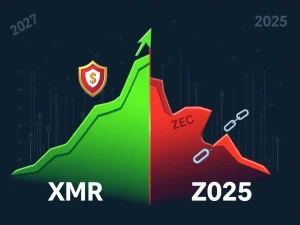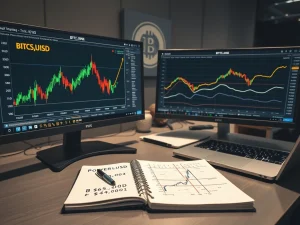S&P 500 Soars: Why Affluent Investors Still Prioritize High-Quality Stocks Amid Crypto Market Shifts

Are you a crypto enthusiast wondering why the broader financial markets seem to be buzzing, yet your favorite digital assets aren’t quite hitting those previous highs? The latest insights from Fundstrat’s Tom Lee reveal a fascinating dynamic: despite impressive S&P 500 gains, affluent investors are exercising significant investor caution, particularly when it comes to high-risk ventures. This isn’t just about traditional equities; this cautious stance has profound implications for the crypto market, signaling a broader shift in investment philosophy.
Understanding Investor Caution: A New Market Dynamic
In a surprising twist, even as the S&P 500 posts solid returns, a deep-seated hesitancy pervades the minds of large-scale investors. Tom Lee, a respected voice from Fundstrat, points out that while the market shows strength, affluent individuals are holding back, reluctant to dive into speculative, high-return stocks. This isn’t mere apprehension; it’s a strategic move:
- Prioritizing Fundamentals: Large investors are shying away from companies that lack proven business models, preferring those with tangible performance over market hype.
- Massive Cash Reserves: A staggering $7 trillion in cash remains uninvested, a clear indicator of institutional players’ reluctance to fully embrace the current market optimism.
- Stability Over Volatility: The preference is for established corporations, suggesting a pivot towards stability rather than the aggressive pursuit of volatile, speculative ventures.
This dynamic creates a unique market environment where growth, though present, is somewhat constrained by the absence of large-scale participation in riskier assets. It’s a delicate balance between market resilience and a pervasive sense of caution.
The Allure of High-Quality Stocks in a Shifting Landscape
So, where are these discerning investors putting their money? The answer lies squarely within high-quality stocks, particularly large-cap companies within the S&P 500 index. This strategic emphasis reflects a broader risk aversion that defines the current market climate. Instead of chasing quick, speculative gains, affluent investors are consolidating their portfolios around companies known for:
- Strong Balance Sheets: Companies with robust financial health and manageable debt.
- Consistent Earnings: Businesses that reliably generate profits and demonstrate sustainable growth.
- Market Leadership: Established players with competitive advantages and a proven track record.
This flight to quality is a hallmark of uncertain times, indicating that while the market may be rising, the underlying confidence for widespread risk-taking isn’t yet fully restored. It’s a calculated move to preserve capital and achieve steady, albeit less spectacular, returns.
S&P 500 Gains: What Do They Really Mean?
The headline — S&P 500 gains 2.6% in July — certainly sounds bullish. However, as Lee’s analysis suggests, these gains tell only part of the story. While retail investors have shown signs of bullishness, the market’s trajectory is heavily influenced by the actions (or inactions) of institutional players. The S&P 500’s resilience reflects underlying strength, but the broader market’s potential for sustained, widespread growth hinges on the participation of these large-scale investors in riskier assets. Without their renewed engagement, the growth might be concentrated in specific sectors or driven by a narrower set of factors.
Crypto Market’s Nascent Growth: A Reflection of Broader Trends
The cautious approach extends beyond traditional equities right into the crypto market. Lee notes that enthusiasm for cryptocurrencies has not reached the feverish levels seen in previous cycles. Remember the ‘Mag 7’ phenomenon of 2021, where a handful of tech giants drove significant speculative fervor? The current landscape lacks a comparable momentum in the crypto space. This divergence underscores a broader shift in investor behavior:
- Reduced Speculative Appetite: The appetite for aggressive, high-risk bets in crypto is tempered by current volatility and uncertainty.
- Absence of Institutional FOMO: Unlike past cycles, major institutional players are largely remaining on the sidelines, not yet exhibiting the ‘fear of missing out’ that often propels crypto surges.
- Maturation Phase: This period of caution could be seen as a maturation phase for the crypto market, where the focus shifts from pure speculation to fundamental value and long-term utility.
The absence of widespread adoption of risk-laden assets, including crypto, indicates that speculative growth may still be in its nascent stages, awaiting a confluence of macroeconomic stability and institutional confidence to truly ignite.
Navigating the Market: Actionable Insights for Investors
So, what does this mean for you, the everyday investor? The interplay between caution and potential growth remains a critical factor. While future waves of risk-taking are possible, they depend heavily on macroeconomic stability and renewed institutional confidence. For now, investors are prioritizing diversification and quality over speculative gains. Here are some actionable insights:
- Embrace Quality: Consider allocating a portion of your portfolio to high-quality, large-cap stocks with strong fundamentals.
- Strategic Diversification: Don’t put all your eggs in one basket. Diversify across asset classes, including a measured approach to crypto.
- Stay Informed: Keep a close eye on macroeconomic indicators, Federal Reserve policies, and regulatory developments, as these significantly shape investor sentiment.
- Long-Term Vision: For crypto, understand that its growth might be more gradual and tied to real-world utility rather than pure speculative fervor in the near term.
The coexistence of market resilience and investor hesitancy highlights the complexity of today’s financial landscape. While optimism exists, it’s tempered by the need for structural stability and robust risk mitigation. The path forward will likely depend on how effectively these forces align to foster a balanced approach to risk and reward.
Conclusion: A Cautious Ascent
The current market narrative is one of cautious conservatism, driven by institutional players, juxtaposed with latent potential fueled by evolving macroeconomic conditions. The S&P 500‘s upward trajectory is undeniable, yet it’s a climb marked by a discerning eye towards quality and a significant degree of investor caution. For the crypto market, this means a period of foundational growth rather than explosive, speculative surges. As investors continue to favor high-quality stocks and maintain substantial cash reserves, the stage is set for a nuanced market evolution, where stability might just be the new frontier for impressive market gains.
Frequently Asked Questions (FAQs)
Q1: Why are affluent investors so cautious despite S&P 500 gains?
Affluent investors are prioritizing stability and proven fundamentals over speculative, high-risk assets. They are wary of market hype and prefer companies with strong balance sheets and consistent earnings, leading to significant investor caution and a shift towards high-quality stocks despite overall market gains.
Q2: How does this investor caution impact the crypto market?
The cautious stance of affluent investors extends to the crypto market, where enthusiasm hasn’t reached previous speculative levels. This suggests that the crypto market’s growth may be more nascent and tied to fundamental developments rather than widespread institutional speculation, indicating a more measured path to market gains.
Q3: What are ‘high-quality stocks’ and why are they preferred now?
‘High-quality stocks’ typically refer to shares of companies with strong financials, consistent profitability, and established market leadership. They are preferred during periods of investor caution because they offer greater stability and a perceived lower risk compared to speculative ventures, making them attractive amidst S&P 500 fluctuations.
Q4: What does the $7 trillion in uninvested cash signify?
The $7 trillion in uninvested cash signals a significant hesitancy among institutional players to fully commit to the market. It reflects a desire to wait for clearer economic signals and greater stability before deploying capital into riskier assets, highlighting the pervasive investor caution.
Q5: Should retail investors follow the same cautious approach?
While retail investors may have different risk tolerances, understanding the cautious stance of affluent investors provides valuable context. It suggests a focus on diversification, quality, and staying informed about macroeconomic factors. A balanced approach, considering both growth opportunities and risk mitigation, is generally advisable.









